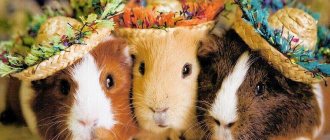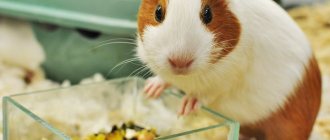Before you buy a guinea pig, you should think about who it will live with and be friends with. We are talking about other pets that are already long-time residents in your home or are still planned to settle in the near future. To avoid conflicts and troubles, you need to know some of the features of the relationship between guinea pigs and other pets. With whom can a guinea pig peacefully coexist in the same territory, with whom can it perhaps make friends, and with whom are friendly relations impossible under any circumstances?
Can an animal exist only with its owner?
To figure out whether a pet can live alone, you need to consider its behavior in the wild. In their natural environment, animals live in groups. They live together, hide from adversity, take care of each other. In the company they feel safe and happy. Therefore, the statement that a guinea pig can live alone is a misconception.
Most owners say that the pet experiences happiness from the presence of the owner and playing together. If a rodent feels good next to its owner, this does not mean that he does not want a friend to live nearby who will lie with him, eat and clean his fur. And we must not forget that the owner does not have the opportunity to constantly be near his pet.
It is not recommended to keep your pet with other rodents, but a rabbit, hamster, or rat would be a good companion. It should be borne in mind that they can harm each other, so it is better to plant them separately, but so that they can see each other.
How do guinea pigs behave?
These animals are cute and interesting pets, and watching how they behave is a real pleasure. By the behavior of a guinea pig you can understand what mood it is in, how it feels; determine whether she is hungry. If the person who gets a guinea pig already has such animals, he will quickly be able to distinguish their characters.
For example, one pig is calm, another is active, and the third is timid.
Guinea pigs, or cavias, are social and friendly animals by nature. They are not characterized by attacks of aggression and other habits that are seen in other rodents.
They are characterized by poor tolerance to loneliness, a high need for daily communication with the owner and movement around the apartment.
People who get such an animal for the first time note that after a while the animal’s behavior changes. If the owners do not have time to communicate with the pet, the animal will be bored, become lethargic, lose appetite, its skin will begin to itch and its hair will fall out.
To eliminate all complications in the animal’s well-being, he needs to purchase a pair. The second guinea pig may be of the opposite sex. Two females can also get along well together, but whether two males can get along in the same house depends on the breed of pets purchased.
If the animal is not the only pet, this is not a problem. He will easily make friends with the rest of the residents of the house. Pigs have good connections with rabbits, hamsters, dogs, cats and even birds.
The main dangers for a guinea pig are large differences in diet with other animals and possible infections.
Their owners also note that animals quite often lick their owner's hands. Sometimes this is due to the fact that the hands have a specific smell, and in other cases this action of the animal is a gratitude for the attention received. A guinea pig can express its devotion to its owner by licking its owner's hands.
Making friends with two pigs is quite easy. By their natural qualities, they are communicative, and living together is not only more convenient, but also more fun. Thanks to active games, they are in motion most of the time, which has a positive effect on their physical fitness and health.
Pair for the animal
Two guinea pigs in one cage is definitely a good thing, but you need to know that some pairs do not get along well together:
- Animals of different sexes;
- several males;
- Kavya girls raised separately.
It must be taken into account that once a male and a female are together, they will definitely begin to reproduce. But at a young age, ligaments are harmful and can even lead to death.
Two male guinea pigs in the same cage may begin to compete and fight after a while. Two girls who grew up together get along well.
NO! solitary content
“Can my pig live alone?”
– Do you spend 24 hours a day and 365 days a year with your pig? – Do you brush her fur? – Do you popcorn and run around with her, exploring the territory? – Are you lying with her, tucked under your side? – Do you speak pig language? – Do you understand all their sounds and can you communicate in the same way?
If you cannot answer these questions affirmatively, then your pig needs a relative.
Why should pigs never be kept alone? Wild relatives of domestic pigs live in large colonies. Many ears and noses sense danger better. Together, pigs look for food, take care of their offspring, play with each other, clean their fur, or simply lie leaning against their friend’s side. Pigs only feel confident and good if they have the opportunity to communicate with their own kind. This social behavior is inherent in evolution. Having a fellow friend is a fundamental need for these animals.
Arguments for single content that, unfortunately, we still hear:
“My pig is happy alone, she is very tame” How does a person know if a pig is happy? Is this what the animal says? No. Is a pig happy if it runs after a person? No. The pig is lonely and looking for company. But a person cannot replace a pig's relative. A person does not play with a pig the games that a relative plays with it, does not lie down on its side, does not share food from a bowl with it, does not inspect the territory, is not able to imitate the pig’s body language, or reproduce its sounds.
“My pig is not alone - I play with her” Imagine a person who lives on a desert island and his only companion is a pig. Would you say that this man is not alone? Humans are unable to understand the complex language of pigs. Every movement of the ear, nose, body, every sound means something for a relative. But not for humans. The pig does not receive proper communication from the person. During the day, people usually work or study. Meanwhile, the pig is forced to serve this time in solitary confinement. At night people sleep, the pig is again left alone. A pig with a friend never feels lonely. It doesn't matter how long a person is gone. Even if you spend 4 or more hours a day with your pig, there are 24 hours in a day. And the rest of the time the pig is alone. Based on 4 hours of interaction with your pig per day, that leaves 600 lonely hours per month and 57,600 lonely hours in the pig's entire life. Even good housing (large cage, aviary or free housing) cannot satisfy the pig's need to communicate with its relatives.
“My pig can’t stand the presence of other pigs.” Antisocial pigs are very rare. As a rule, any pig can be made friends with a relative. Three conditions: a spacious cage (from 100 cm or more for 2 individuals), plenty of food, toys in duplicate (hammocks, shelves, pipes). If you lock two pigs in a cramped cage, the consequences may be fights, while pigs are very friendly animals. But due to lack of space, even they can get stuck. Two unfamiliar pigs need to establish a hierarchy. It is also necessary to follow a number of rules when introducing two pigs. Often owners interfere in the hierarchical struggle of animals, thereby not giving them a chance to find out their rank in the group. There is another common myth that two males do not get along. As practice shows, in most cases they get along well, provided all the listed conditions are met.
“The book says/the pet store said/the breeder said that pigs should be kept alone.” What kind of book is this that goes against the very nature of the pig, the sociality of which was proven by Charles Darwin? Authors of books about guinea pigs in Russia refer to industrial animal husbandry. Nobody thought about the needs of animals. As a rule, people without proper knowledge of biology and veterinary medicine work in a pet store. These people are sellers. They can sell pigs today and shoes tomorrow. Their goal is to sell. And they will do everything to make you buy. They do not represent a source of reliable knowledge. Breeders are different. And most often these are, again, ordinary sellers. It doesn’t matter that a person has ten years of breeding behind him. This does not oblige him to treat his animals well. For amateur breeders, everything is aimed at quantity, not quality.
“My pig is friends with a rabbit/cat/dog, etc.” Pigs communicate with their relatives using a set of specific communicative gestures and sounds. Neither a rabbit, nor a cat, nor a dog, nor other animals speak this “language”. Cohabitation with animals of other biological species is forced by man. In nature, a pig would never be friends with predators (cats and dogs) or rabbits (different habitats). The rhythm of life of pigs is significantly different from the rhythm of life of rabbits. And don’t forget the predatory nature of cats and dogs. Even if the owner claims that for many years the cat was lazy and afraid of mice, and the dog was just playing - at one point nature can still take over! Remember that no amount of domestication will ever completely erase the innate instincts of animals. You can never be sure of animals, since their behavior is governed by instinct. Any behavior of a pig with an animal of another species that is friendly to a person is interpreted by the person as it suits him. However, research shows that peaceful cohabitation between pigs and other animals occurs under coercion. At the same time, the pig continues to remain lonely.
“I don’t have room for two pigs” If a person doesn’t have enough space for two pigs, he shouldn’t have one. Solitary confinement is unacceptable, given the social nature of pigs, and may amount to bullying. In a number of European countries (Germany, Austria, Holland, Switzerland), solitary keeping of social animals is prohibited by law.
“Two pigs – more work and costs” Proper maintenance that meets the needs of animals is not a cheap pleasure. Still, a living being is not a vase or a chair. When getting one animal, you need to accept and satisfy its needs, even if this means acquiring a relative. Two pigs mean double the minimum territory, double portions of succulent food, and more frequent visits to the veterinarian. If you properly care for the animals and clean the cage on time, then there will be no more problems with smell and dirt than one. Ultimately, the work and costs will only have a positive impact on the health and psyche of the animals. The costs of treating lonely pigs, who get sick more often than their relatives living in company, are much more significant.
“Many people keep pigs individually and that’s all.” Don’t be guided by the mistakes of others. After all, the psyche and health of your pet depends on it. If someone keeps an animal incorrectly, this is not an argument for improper keeping. Now in Russia many still keep pigs alone, but in Europe owners of only one pig are a minority and face serious fines for violating animal welfare laws. Just because there is no such law in Russia, this omission does not give anyone the right to improperly keep animals.
“My pig lived alone all her life and she doesn’t need anyone.” It doesn’t matter how long the pig lived alone. Every second of her lonely life she missed communication with her own kind. Lonely pigs sometimes need to relearn social behavior, but after a while they integrate into the group without any problems. At this moment, you can watch how the once lonely pig blossoms before your eyes, basks with its relatives, allows itself to be sniffed, communicates, makes different sounds and pops corn again.
“I want my pig to remain tame” Quite selfish, isn't it? Your pig is completely dependent on you and your desires. And in your opinion, she should remain alone all her life? Is it good if a pig, out of loneliness, prefers the company of anyone, even a human, just so as not to be completely alone? Wouldn't it be better if your pig approached you because he saw you as a friend, and not as a dubious way out of his isolation? Pigs living with relatives are also tame. If you give pigs a little attention every day, they will remain just as tame. Moreover, their psyche is balanced, since their instinct to communicate with their own kind is satisfied. A more tame pig can help a more timid piggy establish contact with the owner. For humans, it becomes possible to observe the natural habits of pigs that live in a group. There is nothing worse than a pig sitting alone in the corner of a locked cage!
There is not a single reasonable argument in favor of keeping pigs alone. There are only excuses and excuses that are convenient for a person. Anyone who thinks about an animal and truly loves it will never keep a pig alone.
What do the studies say? Lonely pigs move much less than pigs living with relatives. In addition, lonely animals eat much more out of boredom, which quickly leads to obesity. Some gilts exhibit serious behavioral problems. Despite the opportunity to hide, pigs always choose a place next to their relative. “The most common problem with keeping pet pigs is the monotony in the lives of these animals and the resulting boredom. The consequences of such content are behavioral disorders. Therefore, keeping pigs (and other animals) should provide the animals with motivation and variety. The most important factor for pigs that are social by nature is the presence of a mate. 50% of a pig’s daily behavior consists of social contacts with its relatives.” Federal Association of Veterinary Practitioners Germany
Excerpts from legislation regarding solitary confinement of social animals: Switzerland “Animals of socially living biological species must be provided with appropriate social contacts with their relatives.” “Tieren soziallebender Arten sind angemessene Sozialkontakte mit Artgenossen zu ermöglichen.” Tierschutzverordnung (TSchV) vom 23. April 2008 (Stand am 1. April 2011) Austria “Whoever keeps an animal is obliged to provide it with social contact, based on the characteristics of the species of the animal, its age, degree of development and domestication, according to physiological and ethological needs. » “Wer ein Tier hält, hat dafür zu sorgen, dass […]die Möglichkeit zu Sozialkontakt unter Berücksichtigung der Art, des Alters und des Grades der Entwicklung, Anpassung und Domestikation der Tiere ihren physiologischen und ethologischen Bedürfnissen angemessen sind. Bundesgesetz über den Schutz der Tiere (Tierschutzgesetz – TSchG)§ 13, Abs. 2, TschG
Source: https://diebrain.de/I-einzel.html
How to choose a company
You need to be guided by the fact that how rodents get along together. Don’t be nervous that the animals will start competing, because they are easy to make friends with. A large cage, toys for both and separate bowls will help avoid conflicts between rodents. It should be remembered that you cannot place a male with a female, since the inevitable mating will only interfere, especially at a young age, there is a risk of death. Even if the birth is successful, the animal will need rest for about 3-4 months, and the male will not stop, which can cause another pregnancy.
Owner reviews
Naturally, elite guinea pigs are not available to the average buyer. In any case, if you plan to breed them, purebred specimens should be selected.
Interesting to know! Experimental research on rabbit breeding in our country has not yet reached such a high level as abroad. And yet, true connoisseurs of these animals try to buy individuals with an attractive and exotic appearance.
It should also be remembered that long-haired and short-haired breeds cannot be crossed, as the result will be offspring that are of poor quality crossbreeds, and no one will allow them to put on a show. Moreover, crossing different breeds is also unacceptable. and because it prevents the improvement of the racial data of both species.
Guinea pigs have earned the right to be considered one of the most wanted pets. Ease of care and maintenance is acceptable for everyone, even novice owners. This is an affectionate and sociable animal, great for families with children.
Basic Commands
| Sound signal | Pet action | Taming principle | |
| 1 | To me | At the sound of the name he runs up to the owner | A call to come closer, the distance is gradually increased |
| 2 | Give me your paw | Places paw on outstretched palm | Force you to lean on your hand to reach food |
| 3 | Serve | Lifting onto hind legs | Hold the treat over the muzzle |
| 4 | All around | Rotating in a circle | The hand with the food makes a circular motion |
| 5 | Bounce | Jump over the ring rim | The ring is placed between the animal and the food |
| 6 | All around | Moving the muzzle closer to a person's lips | Squeeze a sprig of greenery with your lips |
Necessary for care
Like any other pet, a guinea pig requires a wide variety of grooming accessories. These include:
- cage or aquarium;
- feeder;
- sippy cup;
- house;
- filler;
- mineral stone;
- toys;
- carrying;
- hygiene products;
- brush-comb and nail clipper.
Cage or aquarium
Keeping a guinea pig is allowed both in an aquarium and in a cage. The main condition is size: the dwelling must be at least 50 cm in length and 30 cm in height so that the animal can move comfortably. If you have decided on a cage, then it is best to take a closer look at the options that have a plastic bottom. Plastic is quite easy to care for, it is easy to wash, dry, etc. A wooden base is not suitable due to the fact that these animals drink a lot of liquid per day, and therefore excrete a large amount of urine. The wood will simply become unusable in a very short time. You can purchase an aquarium in the above sizes. It, like a cage with a plastic bottom, is easy to wash and clean. But you should be careful, since glass is a very fragile material and when moving it, for example, to another room, you should follow safety rules (the pet should not be in the aquarium, it should be transferred to a carrier).
cell
Feeder
The feeder should be heavy enough so that the guinea pig cannot knock it over. An excellent option would be bowls made of ceramics, stainless steel, etc. It is also recommended to buy 2-3 containers. For example, one will be used for vegetables or fruits, and the second for dry food.
Sippy cup
A vertical ball sippy cup is perfect for a guinea pig. It is usually made of plastic with a metal tip. In such a drinking bowl there is no need to change the water daily, but this is done about 2-3 times a week.
House
Be sure to install a small house in the cage or aquarium. Your pet will sleep in it, relax, or simply retire when he wants to be alone. Most often, such houses are made of wood with a round “door” cut out in the middle. The most optimal size is 25 cm in length and 15 cm in height. This space is enough for the animal to hide and at the same time feel comfortable.
house
Filler
When arranging the cage, do not forget about the bedding. It will create comfort in the cage, prevent the animal from freezing and, to some extent, maintain cleanliness. You can use sawdust or ground corn cobs as a filler. Under no circumstances put cotton wool, newspaper, paper, etc. in the cage as bedding, as this is not safe for your pet’s health.
Mineral stone
To maintain dental health and calcium levels in your guinea pig's body, mineral stone is essential. After all, it serves not only as a vitamin complex, but also perfectly helps the animal grind its teeth. This stone is sold in a pet store, and its price is quite affordable.
stone
Toys
Guinea pigs are somewhat similar in behavior to decorative rabbits. They love to play. Therefore, be sure to buy some interesting and funny toy for your pet, for example, a tunnel, a hammock, a mirror, a rolling wheel, etc. The game will not only bring joy and pleasure to the animal, but will also strengthen muscles, and will also be an excellent preventive measure against obesity.
Carrying
If your plans did not include traveling together or any trips with your guinea pig, then you will still need a carrier. Transporting an animal in your arms, in a box or blanket is strictly prohibited. For example, you need to visit a veterinarian or transport the animal to another house or apartment; in such life situations, a carrier will definitely help you out. The pig will feel safe and the transportation process will go smoothly.
Hygiene products
Guinea pigs are considered clean animals, but sometimes they are still allowed to be bathed. For such cases, it is necessary to use special hygiene products that can be purchased at a pet store. The most popular of them:
- "Biogance" - bio-perfume;
- "Veda" - wheat shampoo.
Brush-comb and nail clipper
Caring for your guinea pig's coat and claws is extremely important. To do this, you need to purchase a special comb with soft bristles (combing is done daily), as well as a nail clipper for trimming the claws (the procedure is performed as they lengthen).
Toilet training
Toilet training can go quite smoothly, but there are times when the owner needs to be patient, and sometimes even come to terms with the fact that the pet will defecate in different corners of the cage.
The training process takes place in several stages:
- Choosing a location. The animal itself will do this; the owner only needs to observe where the pet most often goes to relieve itself.
- Installation of a toilet.
- Bait. Place a bunch of hay and some used bedding or a few peas of feces in the tray.
- Encouragement. When the rodent has done its job in the right place, you need to treat it with a treat.
If, after installing the litter tray, your pet has changed the place to defecate or goes here and there, then you can install several toilets or remove them altogether.
The pet can use the tray as a storage room or a place to sleep.
In this case, it is necessary to reconsider the structure of his home; perhaps he does not have a very comfortable house or does not have enough space to store supplies.
No allergies
Many people have to give up the idea of having a pet at home just because a pet will complicate their health. When faced with an allergic reaction, most of us would rather play it safe. And this is the right approach. Even after reading a bunch of positive reviews about the pros and cons of guinea pigs, not everyone will agree to keep an animal at home. Although in fact, these small furry animals do not cause any allergies. Unlike cats and dogs, they are unlikely to make a person feel unwell. They will be incredibly comfortable for both an elderly pensioner and just any caring adult or child. This is truly gratifying and pleasant.
Taming
Training a guinea pig is easy if it trusts its owner, so before you teach the animal commands, you need to tame it. It is better to start taming immediately after purchasing a pet. This will help establish rules for the rodent's behavior in the house and train it to use the toilet.
How to tame a guinea pig:
- First, the pet's cage is covered with thick fabric so that it is dark enough inside. This will allow the animal to focus on sounds, smells and tastes.
- During the first days, the owner talks to the pig in a quiet, calm voice.
- After a couple of days, you can offer the animal a treat (apple, pear, gooseberry, etc.).
- After a week of getting used to it, the thick fabric cape should be replaced with a translucent one.
- The animal will gradually get used to the sight of the owner and his hand holding out a treat.
- After another week, the cover is removed. It is better to give the pig the opportunity to look around at the surroundings and leave the room for a while.











